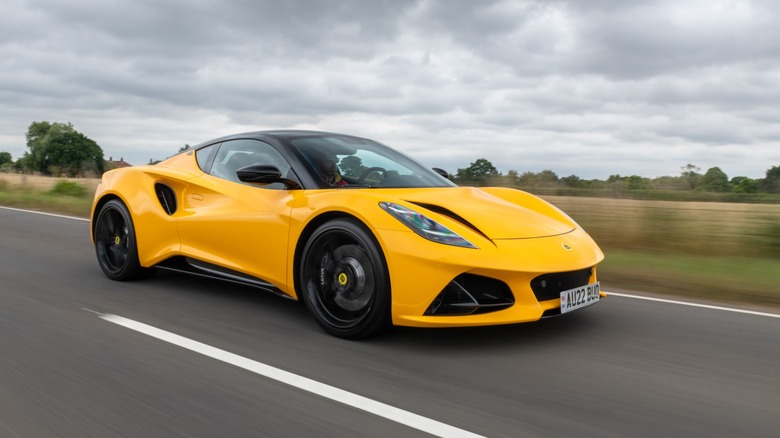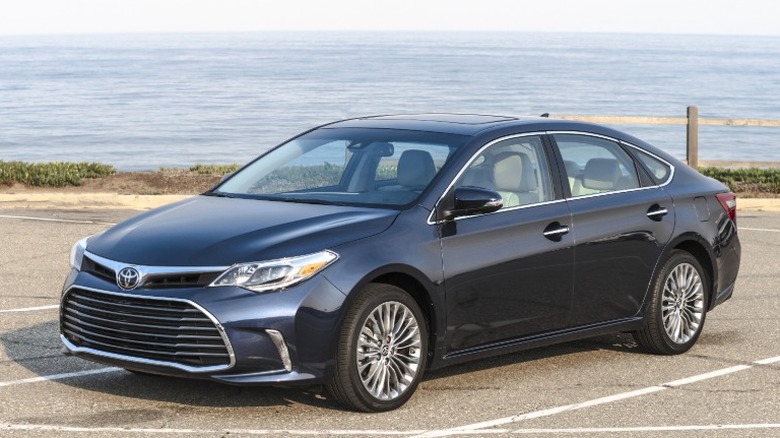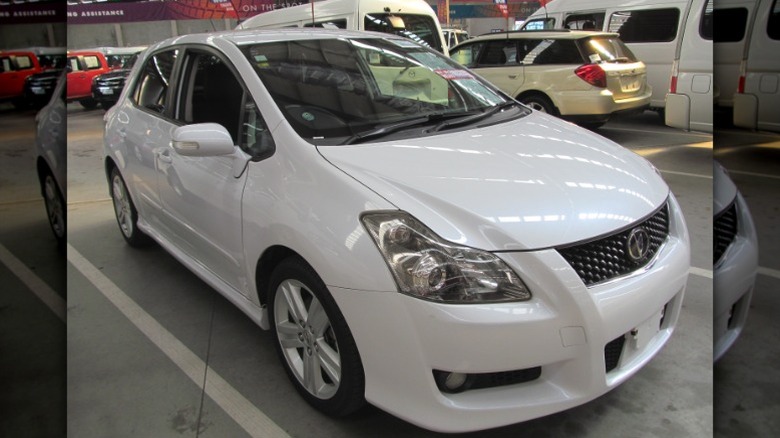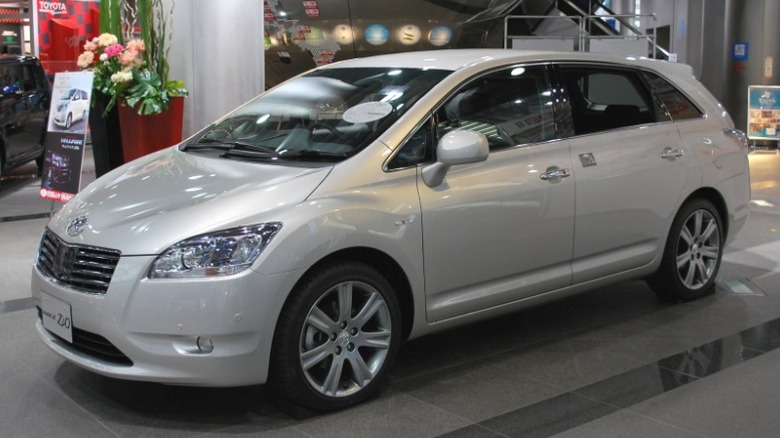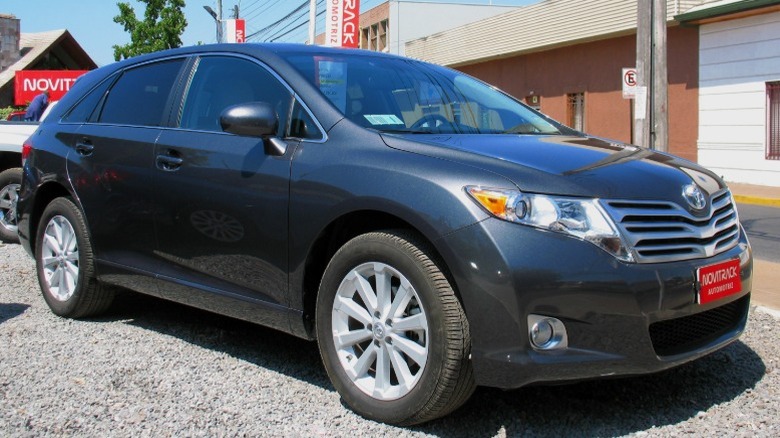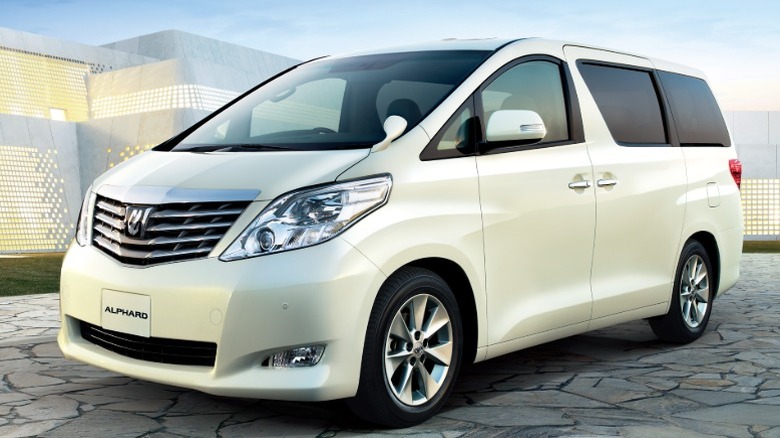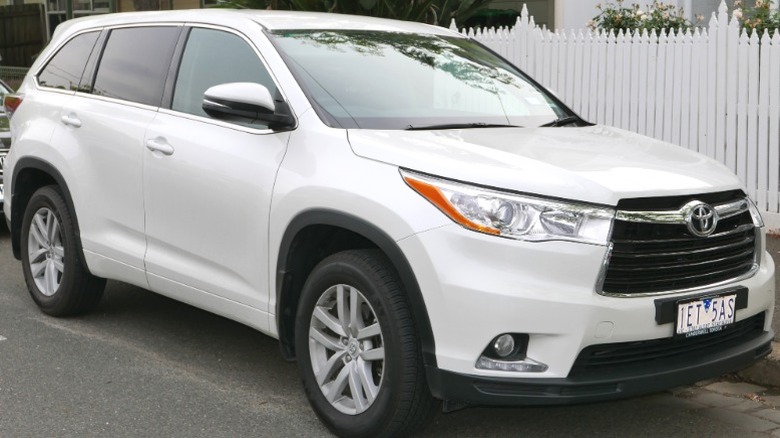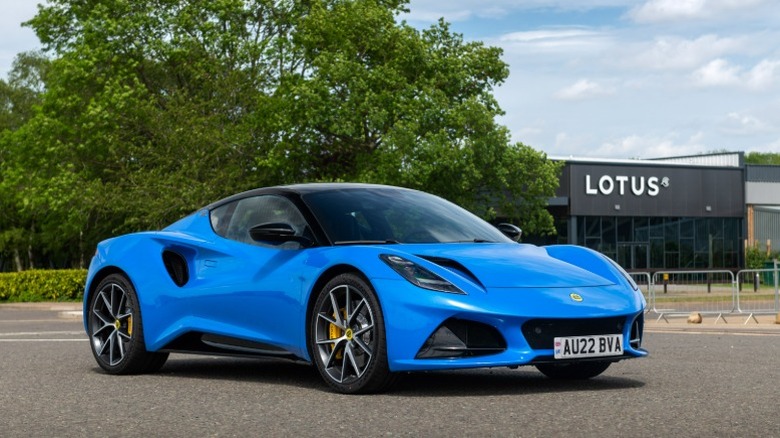13 Cars Powered By Toyota's 2GR-FE V6 Engine
Toyota's 2GR-FE is a 3.5-liter V6 with a reputation for being one of the company's most reliable engines. Derived from Toyota's V6 truck engines of the time, the 2GR-FE was first seen in cars like the 2005 Toyota Avalon, before featuring in a wide range of Toyota offerings over the next decade or so. These would range from American-market offerings such as the RAV4 and Venza to more obscure Japanese-only models such as the Mark X ZiO and Blade Master.
Lotus would also get in on the 2GR-FE party, choosing the V6 to power its 2009 Evora and a couple of other models afterward. It's also the only company still using the original 2GR-FE; Toyota itself started moving away from the FE in 2016, when it introduced the 2GR-FKS in the 2016 Tacoma. The latter was based on a variant of the 2GR-FE called the 2GR-FSE, and featured a dual-injection system — port and direct injection — as one of its major differentiators. The GR V6's later variants are a story for another time. For now, let's focus on a selection of vehicles powered by the original 3.5-liter 2GR-FE engine.
Toyota Camry (2007 - 2017)
There are a handful of nameplates that have cemented Toyota's standing as one of the world's most prominent — and best-selling — automakers, and one of them is the Camry. Easily one of the most successful Toyota models ever, the Camry debuted as the Celica Camry in 1980 before becoming its own model in 1982. There have been nine generations of the Camry since then, with two generations sporting the much-loved 2GR-FE V6 under the hood.
Toyota unveiled the sixth-generation Camry in 2006, first in Japan, where it only came with a 2.4-liter inline-four cylinder. The American-market version, announced soon after, was available with the 3.5-liter V6 in SE, LE, and XLE variants. Like almost all of Toyota's other uses of the 2GR-FE, the V6 Camrys made 268 hp and 248 lb-ft of torque, good enough for a 0-60-mph time of 6.8 seconds in MotorWeek's hands.
Toyota kept the 2GR-FE V6 in the seventh-generation Camry, which debuted for the 2012 model year. The seventh-gen Camry's V6 made the same power, but had improved fuel economy and was now limited to the Camry's SE and XLE trims.
Toyota Avalon (2005 - 2018)
The Toyota Avalon is quite a storied nameplate. When it debuted in 1995, it was the first six-passenger sedan from a Japanese automaker to be sold in the U.S., offering more room inside than other Japanese sedans and competing directly against offerings from American automakers such as Buick and Mercury. It was also one of the first Toyotas that the automaker built exclusively at its Georgetown, Kentucky, facility. In 2005, the third-generation Avalon became one of the first Toyota passenger cars to receive the 3.5-liter 2GR-FE.
The 2005 Avalon was a decisive break from the somewhat staid first two generations, with a modern (for the time) design from the company's Calty studios. It also had a healthy 280 hp and 260 lb-ft of torque from the 2GR-FE, the only engine available to buyers. This was a huge improvement over the previous model, which had a paltry 210 hp and 220 lb-ft of torque.
Toyota kept the 2GR-FE under the hood for the first few years of the fourth-generation Avalon, which it unveiled in 2012. Riding on the same platform as the Lexus ES of the time, the new Avalon's 2GR-FE made 268 hp and 248 lb-ft of torque. It lasted until Toyota moved the sedan to its TNGA platform for the 2019 model year. That didn't last long, though, and Toyota discontinued the Avalon after the 2022 model year.
Toyota Blade Master-G (2007 - 2009)
There have been many 2GR-FE-powered Toyotas over the years, but we're willing to guarantee that none have been quite as pleasingly named as the Toyota Blade Master-G from the mid-2000s. But before we get to the Blade Master, we first have to discuss the Blade. The Toyota Blade entered Toyota's JDM lineup in late 2006 as a higher-end variant of the Auris, which had debuted earlier in the year as a successor to the Corolla hatchback.
The Blade's upgrades over the Auris mostly involved aesthetics and comfort — such as visual changes and improved interior materials — although it also adopted the double-wishbone rear suspension available on the European-market Auris models. The Blade came with the 2.4-liter 2AZ-FE inline-four to start with, but Toyota cranked things up in August 2007 when it dropped the 3.5-liter 2GR-FE into the engine bay, creating the 276-hp Blade Master-G, a hatchback that could be viewed as a precursor to the much-loved Toyota GR Corolla.
Toyota allegedly sold fewer than 3,000 of these over its three-year run, mostly in Japan — although a few did make their way to New Zealand. The automaker launched a new generation of the Auris in 2012, but did not revisit the Blade name.
Toyota Mark X ZiO (2007 - 2013)
If you look at that name and think that it would never sell in America, you'd be right; it didn't. The Mark X ZiO from 2007 was a JDM-only Toyota model based on the Japanese-market Mark X sedan that had debuted a few years earlier in 2004. But unlike the Mark X, which came in RWD and AWD configurations and sported either the 3GR-FSE or 4GR-FSE V6s, the Mark X ZiO was a FWD or AWD minivan-cum-station wagon sporting either the 3.5-liter 2GR-FE or 2.4-liter inline-four 2AZ-FE under the hood.
Toyota's 3.5-liter V6 made 276 hp (280 ps) in the Mark X ZiO, more power than the Mark X of the time, which made a maximum of 253 hp when equipped with the 3GR-FSE. The extra power probably had nothing to do with performance, though; with an extra 286 pounds of curb weight to cart around and an interior that could fit up to seven passengers, the Mark X ZiO needed all the help it could get.
The interior was probably the Mark X ZiO's most interesting feature; Toyota's press release announcing the ZiO made special note of what it called a "three-mode cabin," where users could configure the interior as a sedan, station wagon, or minivan, covering and raising seats as necessary. Toyota discontinued the Mark X ZiO in 2013.
Toyota Venza (2009 - 2015)
First unveiled to the world at the 2008 North American International Auto Show, the Toyota Venza was an attempt to offer buyers a mid-point between sedans and station wagons, not entirely dissimilar to what it had done in Japan with the Mark X ZiO. But where the ZiO could hit full-on minivan territory in seven-seater configuration, the North American Venza topped out at five passengers — probably not a bad move, considering how unpopular minivans were at the time.
One area where the two were identical, though, was in the engine bay: V6 versions of the Venza — available in FWD and AWD — sported the same 3.5-liter 2GR-FE V6 as the Mark X ZiO. The V6 Venza's numbers were 268 hp and 246 lb-ft of torque, good for a 60 mph run in 8.4 seconds in Car and Driver's hands. Not particularly impressive, but that likely wasn't the point; the outlet appreciated the car's easy-going, fuss-free demeanor and good value, although that didn't help it become a hit.
Toyota eventually discontinued the Venza in 2015 after sales nosedived to 29,991 units in 2014. That wasn't the end of the nameplate, though. The company revived it in 2021 (sans 2GR-FE) but discontinued the Venza again at the end of 2024.
Lotus Evora (2009 - 2021)
The late 2000s were arguably the 2GR-FE's heyday, with the V6 having made its way into all of the Toyota nameplates that would ever make use of it. But Toyota wasn't the only company that saw the potential of the 3.5-liter powerplant. Lotus had been using Toyota engines for a good few years, with models like the 2004 Exige sporting the 1.8-liter 2ZZ-GE under the hood. And so, when the time came to expand its lineup, Lotus turned to another Toyota engine to power its new car.
Lotus launched the Evora in 2009, marking the British automaker's first all-new product in nearly 15 years. A 2+2 slated to compete against Porsche's 911 and Cayman, the Evora had the 2GR-FE under the hood, where it made 276 hp and 252 lb-ft of torque — good enough to hit 5.1 seconds in Car Magazine's testing.
But that wasn't the end of it: Lotus cranked the power up with racier variants over the years, taking the 2GR-FE to a whole new level. The first of these was the 345-hp Evora S from 2011, and Lotus' supercharging efforts peaked with 2017's Evora GT430, which squeezed out 430 hp and 325 lb-ft from the same Toyota Camry engine the Evora debuted with.
Lexus RX 350 (2006 - 2015)
First launched in European markets such as the U.K. in 2003 as the Lexus RX 300, Lexus' luxury SUV packed a 3.0-liter V6 under the hood. It later came to the North American market as the RX 330 for the 2004 model year, with a larger 3.3-liter V6.
The RX 330 lasted until the 2007 model year, when Toyota upgraded it by dropping the 3.5-liter 2GR-FE into the engine bay to create the Lexus RX 350. The new engine had more power, of course, its 270 hp was a notable increase over the 223 hp that the old engine offered. While performance likely wasn't the main goal, the 3.5-liter did bring the 0-60-mph time down by a full second, with the RX 350 hitting the milestone in 6.8 seconds (via Car and Driver).
The third-generation RX 350 debuted for the 2010 model year in North America, retaining the 2GR-FE with a hair more power and the welcome introduction of a six-speed gearbox. It also debuted in Japan, marking the first time Toyota sold the Lexus RX 350 in its home market. The 2GR-FE lasted through the third generation, making way for the 2GR-FKS when the fourth generation became available for 2016.
Toyota RAV4/Vanguard (2006 - 2012)
Toyota unveiled the third generation of its best-selling RAV4 SUV at the Frankfurt Motor Show in 2005, with a range of engines available depending on the region. European-market RAV4s had a 2.0-liter petrol engine alongside a couple of 2.2-liter diesels, while the Japanese RAV4 used the 2.4-liter 2AZ-FE in all configurations. American-market RAV4s also came with the 2.4-liter engine as standard, but offered the 269-hp 2GR-FE as an option.
The 2GR-FE paired with a five-speed manual gave the RAV4 decent performance. Car and Driver tested a V6-equipped RAV4 Limited 4WD and recorded a 0-60 mph time of 6.3 seconds. While that may not sound like much, the outlet pointed out that it was only 0.4 seconds behind a HEMI-powered Dodge Magnum of the time.
Toyota later brought the V6 RAV4 back to Japan as the Vanguard in 2007. Toyota discontinued the original Japanese-market RAV4 outright that year, with the Vanguard — in both 2AZ and 2GR variants — taking its place and that of the Harrier and Kluger. The 2GR-FE didn't last long in the RAV4, though, with the fourth-generation RAV4 from 2013 only available with a 2.5-liter inline-four.
Toyota Estima/Tarago (2006 - 2019)
Toyota may currently only offer one minivan in the U.S., namely the ultra-reliable Sienna, but that wasn't its first foray into American-market minivans. The Estima debuted in 1990, and was known as the Previa in the U.K. and U.S. But while the American-market Previa made way for the Sienna in 1997, the Estima original continued in other regions and would eventually be blessed with the 2GR-FE.
The third-gen Estima debuted in 2006, with buyers given the choice of either 267-hp 2GR-FE or a 2AZ-FE four-pot. The V6 came with a six-speed auto, and the Estima was available in several trim levels with either seven or eight seats. Toyota also brought the Estima to Australia as the Tarago, a nameplate it had used since the 1980s for a rebadged TownAce van.
By 1991, however, the Tarago name was given to the Estima/Previa minivan, and it continued to bear the Tarago name when the 2GR-FE-powered fourth-generation version hit Australian shores. Toyota dropped the Estima's V6 in 2016, although the Tarago looks to have kept the 2GR-FE until its discontinuation in 2019.
Lotus Exige (2012 - 2022)
The 2GR-FE in the 2009 Lotus Evora impressed reviewers, despite its humble Toyota origins, so it makes sense that Lotus would use the 3.5-liter V6 when it came time to update the Lotus Exige in 2012. Previously sporting Toyota's 1.8-liter 2ZZ-GE, the third-generation Exige debuted at the 2011 Frankfurt Motor Show with Toyota's 3.5-liter V6 under the hood. Supercharged from the get-go, the 2GR-FE made a healthy 345 hp, and only increased from there.
Lotus first unleashed the Exige Sport 380 in 2016, which managed 375 hp and 302 lb-ft. There was also the Exige Cup 430 from 2017, with — you guessed it — 430 hp and 325 lb-ft of torque, allowing it to hit 60 mph in a claimed 3.2 seconds. In between those two extremes was the 2018 Exige Sport 410, which made 410 hp as a halfway point between the more hardcore Cup 430 and the street-friendly Sport 350.
Lotus eventually ceased production in 2021, but the Exige didn't go quietly into the night. For its final year, Lotus released the Exige Sport 390 Final Edition, which made 397 hp; the Sport 420 Final Edition, with 420 hp; and the Cup 430 Final Edition, which had the same 430 hp as its 2017 forebear.
Toyota Alphard/Vellfire (2008 - 2017)
In America, Toyota isn't likely a brand you'd associate with luxury. But the company has quite a few luxurious vehicles in its stable, especially for buyers in Japan and Asian markets. One great example is the Alphard and its Vellfire sibling, both high-class minivans for buyers seeking a chunky slice of people-carrying luxury.
The Alphard debuted in 2002, but the crucial year, at least as far as this list goes, was 2008. In 2008, Toyota launched an all-new second-generation Alphard alongside a Vellfire variant. Both minivans came in a wide range of trims, with lower-end versions sporting the 2.4-liter 2AZ-FE and the mid- and high-grade trims sporting the 2GR-FE under the hood. The Alphard and Vellfire were mechanically identical and thoroughly luxurious, with the main difference being the Vellfire's sportier look.
Toyota debuted the third-gen Alphard/Vellfire in 2015, and this new version retained the 2GR-FE and a 2GR-based hybrid powertrain that had debuted in 2011. Joining these was a new 2.5-liter 2AR-FE four-cylinder. The 2GR-FE didn't last long in the third-gen minivan, though; Toyota replaced it with the 2GR-FKE when it facelifted the Alphard in 2018.
Toyota Highlander/Kluger (2008 - 2016)
The first of four generations of the Toyota Highlander debuted at the 2000 New York Auto Show for the 2001 model year, riding on the same platform as the Toyota Harrier of the time. Known as the Kluger in Japan and Australia — where it debuted in 2003 — due to a trademark dispute with Hyundai, the SUV was powered by various engines depending on region. In Japan, for instance, it had either the 3.0-liter 1MZ-FE V6 or the 2.4-liter 2AZ-FE.
For the second generation, which debuted in 2007 for the 2008 model year, Toyota swapped the old V6 for the then-new 2GR-FE, displacing its usual 3.5 liters and making 270 hp. The Kluger also received the new engine at the same time, with both models rocking the 2GR-FE until the end of the generation.
The third-generation Highlander debuted for 2014 and retained the 3.5-liter V6 for the first couple of model years, with the same 270 hp and 248 lb-ft of torque. Like many of Toyota's mid-2010s cars, the automaker introduced a new V6 to the Highlander's engine bay during a mid-cycle refresh, with the 2017 Highlander and Kluger sporting a direct-injection 3.5-liter V6, almost certainly the 2GR-FKS.
Lotus Emira (2022 - present)
As of November 2025, only one mass-produced car still flies the flag for the 2GR-FE, two decades on from its debut. That car is the Lotus Emira, which, like its immediate predecessors, uses Toyota's venerable 3.5-liter V6. Debuting in 2022, the Emira was pitched as Lotus' final combustion vehicle, with the mid-engined sports car available with either the 3.5-liter 2GR-FE or an AMG-sourced 2.0-liter turbo four-banger.
Emissions regulations mean that the Emira doesn't make as much power as the most powerful versions of its predecessors, but its 400 hp and 310 lb-ft of torque are still more than enough to impress. Paired with a six-speed manual, the Emira's V6 pushes it to a 60 mph time of 4.2 seconds (via Autoweek), very impressive considering the 2GR-FE's humble roots.
The Emira was slated to be discontinued at the end of 2026 due to the Euro 7 emissions regulations scheduled to take effect in 2027. However, during a Q2 2025 earnings call, Lotus CEO Feng Qifeng announced that the company would keep the Emira alive past that, possibly with a V6. That said, it's unclear whether it'll be the 2GR-FE or another, more emissions-friendly, six-cylinder.
